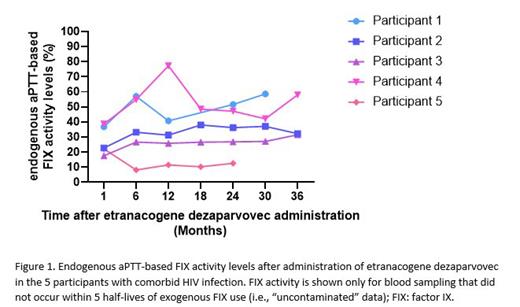Introduction: People living with HIV represent an important subset within the hemophilia community. Concerns about increased hepatotoxicity of liver-directed adeno-associated viral (AAV) vectors in patients receiving potentially hepatotoxic HIV medications (eg, efavirenz) have excluded this population from participating in many of gene therapy hemophilia trials. However, adult patients with hemophilia B (PwHB) with controlled HIV comorbid infection were not excluded from enrollment in phase 2b (NCT03489291) and phase 3 HOPE-B (NCT03569891) trials evaluating the efficacy and safety of etranacogene dezaparvovec (formerly AMT-061), an AAV5 vector containing a codon-optimized, highly active factor IX (FIX) Padua R338L transgene under the control of the liver-specific promoter LP-1.
Aim: The aim of this ad hoc analysis was to evaluate the efficacy and safety of etranacogene dezaparvovec in the subset of adult PwHB with comorbid infection with HIV from both the phase 2b and the phase 3 HOPE-B trials.
Methods: A single IV administration of 2x10 13 gc/kg etranacogene dezaparvovec was administered to adult patients with severe or moderately severe hemophilia B in phase 2b and phase 3 HOPE-B trials. Patients with HIV infections uncontrolled by antiviral therapy demonstrated by CD4+ counts ≤200/µL were excluded from the studies. Individual safety and efficacy outcomes of participants with controlled HIV infection treated with etranacogene dezaparvovec were assessed. Liver enzyme levels and aPTT-based FIX activity levels were analyzed by a central laboratory. Descriptive statistical analyses were used to report all results with a data cut at 3 years post administration of etranacogene dezaparvovec.
Results: Among 57 participants who received etranacogene dezaparvovec in phase 2b and phase 3 HOPE-B trials, 5 had comorbid HIV infection (median [range] age 49 years [38-54]), of whom 4 had a history of treated hepatitis C virus with a negative viral load. Three out of 5 participants with comorbid HIV infection had pre-existing AAV5 neutralizing antibodies with median [range] titer of 20 [0-99]. Annualized bleeding rate (ABR) decreased post treatment compared with previous FIX prophylaxis regimen (with extended half-life FIX products) for all HIV+ patients; median [range] ABR during FIX prophylaxis was 5 [1-10.4]. Two patients recorded no bleeds in the 36 months after receiving etranacogene dezaparvovec treatment, and the overall median [range] ABR post treatment was 0.64 [0-5.0]. FIX activity levels in these participants were apparent from week 3 and were maintained in the mild/normal range for 4/5 (80%) participants (Figure 1). Median [range] uncontaminated endogenous FIX at 3 years post treatment was 32.3% [31.5%-58%]. Two patients had contaminated FIX measurements at 36 months (1 returned to prophylaxis shortly after 24 months and the other took on-demand replacement therapy the day before the 36-month visit). No treatment-related serious adverse events (AEs) occurred. Only 7 treatment-related AEs were reported in 3 participants. Treatment-related ALT elevation of moderate severity occurred in Participant 5 (20%, similar to patients without HIV comorbid infection) at 35 days post treatment and resolved within 15 days with the use of corticosteroids. This patient eventually had his FIX levels declined to 2-5% range; his bleeding phenotype returned, and he resumed prophylaxis per protocol at month 30 post-treatment. Annualized FIX use (IU/year) was reduced between 34% and 100%, with 3 participants who received no FIX infusions through 36 months post treatment.
Conclusion: Etranacogene dezaparvovec were observed to be safe and effective in a subset of study participants living with HIV. These results support the use of etranacogene dezaparvovec, the first approved liver-directed AAV-based gene therapy product for the treatment of patients with severe or moderately severe hemophilia B in the US and Europe, for eligible patients with controlled comorbid HIV infection. Owing to the small number of patients with HIV being enrolled in trials, long-term collection of data and special attention in the real-world setting is recommended.
Disclosures
Pipe:Regeneron/Intellia: Consultancy; Roche/Genentech: Consultancy; Sanofi: Consultancy; Takeda: Consultancy; Pfizer: Consultancy; Novo Nordisk: Consultancy; LFB: Consultancy; Freeline: Consultancy; HEMA Biologics: Consultancy; GenVentiv: Consultancy; Equilibra Bioscience: Consultancy; CSL Behring: Consultancy; BioMarin: Consultancy; Bayer: Consultancy; ASC Therapeutics: Consultancy; Apcintex: Consultancy; Spark Therapeutics: Consultancy; uniQure: Consultancy. Gomez:Chieisi USA, Inc., and Global Blood Therapeutics Inc: Consultancy. Hermans:Bayer, Takeda, Roche, CSL Behring, Novo Nordisk, Pfizer, Sobi, LFB, OctaPharma, Uniqure and Biomarin: Consultancy. Giermasz:Bayer: Honoraria, Membership on an entity's Board of Directors or advisory committees; BioMarin Pharmaceutical Inc.: Honoraria, Membership on an entity's Board of Directors or advisory committees, Other: Travel grants; uniQure: Honoraria, Membership on an entity's Board of Directors or advisory committees; Genentech: Honoraria, Membership on an entity's Board of Directors or advisory committees; Novo Nordisk: Honoraria, Membership on an entity's Board of Directors or advisory committees; Pfizer: Honoraria, Membership on an entity's Board of Directors or advisory committees; Sanofi Genzyme: Honoraria, Membership on an entity's Board of Directors or advisory committees; Bioverativ, Genentech/Roche, Biomarin, uniQure, American Thrombosis and Hemostasis Network: Consultancy, Honoraria, Membership on an entity's Board of Directors or advisory committees. Kampmann:CSL Behring, Novo Nordisk, and BioMarin pharmaceuticals: Consultancy. Lemons:CSL Behring and NovoNordisk: Consultancy. Galante:CSL Behring: Current Employment. LeQuellec:CSL Behring: Current Employment. Monahan:CSL Behring: Current Employment.


This feature is available to Subscribers Only
Sign In or Create an Account Close Modal